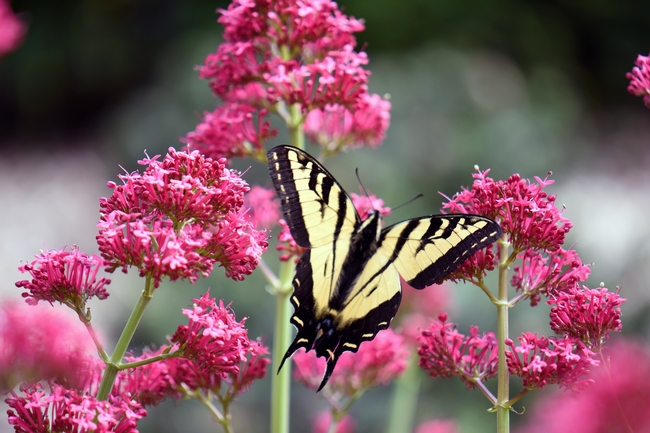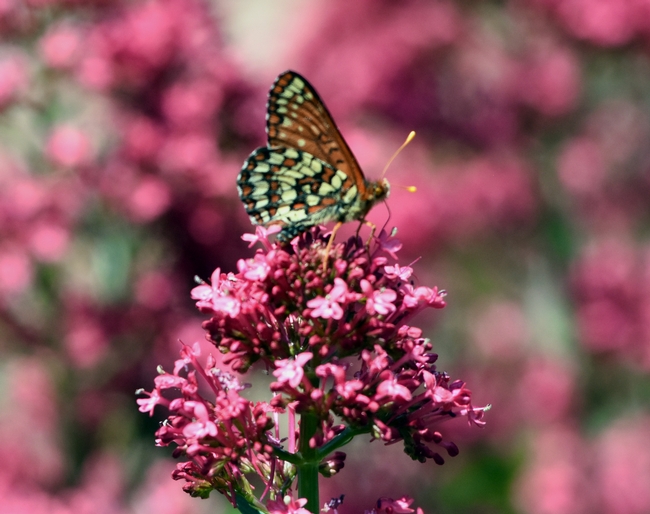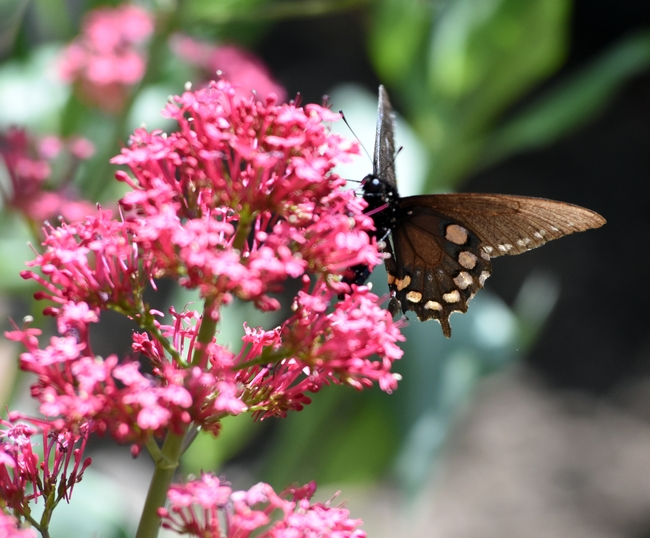Cynthia Kerson

It seeds easily – so easily that it can be invasive if you don't pull up seedlings; it'll easily become a weed in neighboring beds. If you regularly pull the seedlings, and keep it contained, it makes for a colorful, lively focal point. Plant Right, an invasive plant alliance classifies Red valerian as a “Plant to Watch." Plant Right tells us "red valerian is popular for mediterranean gardens, and seems to be more of a roadside weed than a serious threat to California's ecosystems. It has not become naturalized in less disturbed habitats. Therefore, we decided that the risk from this plant is too low to add it to the plant list, and having it as a Plant to Watch is sufficient.”

The Western Tiger Yellow Swallowtail is found along the West coast from British Columbia to Baja California; this one is a female as observed by the 4 stripes on each wing and a crevice between the upper and lower wings. They have a wingspan of 3-4” and are especially attracted towards flowers of this coloration2.

The Northern Checkerspot is found throughout the Western coast (including as far North as Canada) and through the midwestern states as well. It's the smallest of the three I caught pictures of, with a wingspan of only about 1 ½ inches. Their main habitats are coastal chaparral, open woodlands, and streamsides7.
Butterflies are pollinators, eat weeds, and (sadly) provide food to birds, spiders, lizards, and small animals. They usually only last up to a month when they die of old age if not already eaten. Attracting and supporting butterflies, as well as other pollinators (bees and hummingbirds) will keep your micro-ecosystem in check8.
* (For the gardener who, like me, is also into photography, I used my Nikon D7200 with a 80-200 telephoto lens set to shutter priority of 1,000th/sec. so I could capture them without wing flutter.)
Informational links:
Centranthus ruber (Red Valerian)
Missouri Botanical Gardens
https://www.missouribotanicalgarden.org/PlantFinder/PlantFinderDetails.aspx?kempercode=b950
A note of caution about Centranthus ruber (Red Valerian)
Plantright.org https://plantright.org/watch/centranthus-ruber/
Aristolochia californica (Dutchmans Pipe) Calscape-California Native Plant Society
https://calscape.org/Aristolochia-californica-(Dutchmans-Pipe)
Butterfly info
1 UC Davis- Dr. Art Sharpiro prof http://butterfly.ucdavis.edu/
2 UC ANR blogs-The Bug Squad-Author-Kathy Keatley Garvey July 2019
https://ucanr.edu/blogs/blogcore/postdetail.cfm?postnum=30787
3 NABA- North American Butterfly Assn. http://nababutterfly.com/pipevine-pipe-dream-project/
4 UCMG Napa Co.-Author-Penny Pawl March 2020 https://ucanr.edu/blogs/blogcore/postdetail.cfm?postnum=39602
5 Pipevine plant source https://www.laspilitas.com/nature-of-california/plants/90--aristolochia-californica
6 https://ucanr.edu/blogs/blogcore/postdetail.cfm?postnum=17456
7 Butterflies & Moths of North America https://www.butterfliesandmoths.org/species/Chlosyne-palla
8 Sciencing.com https://sciencing.com/what-do-butterflies-do-environment-4580181.html
During Napa County's shelter in place directive that protects everyone's health and safety, Napa Master Gardeners are available to answer garden questions by email: mastergardeners@countyofnapa.org. or phone at 707-253-4143. Volunteers will get back to you after they research answers to your questions.
Visit our website: napamg.ucanr.edu to find answers to all of your horticultural questions.
Photo credits: All photos by Cynthia Kerson